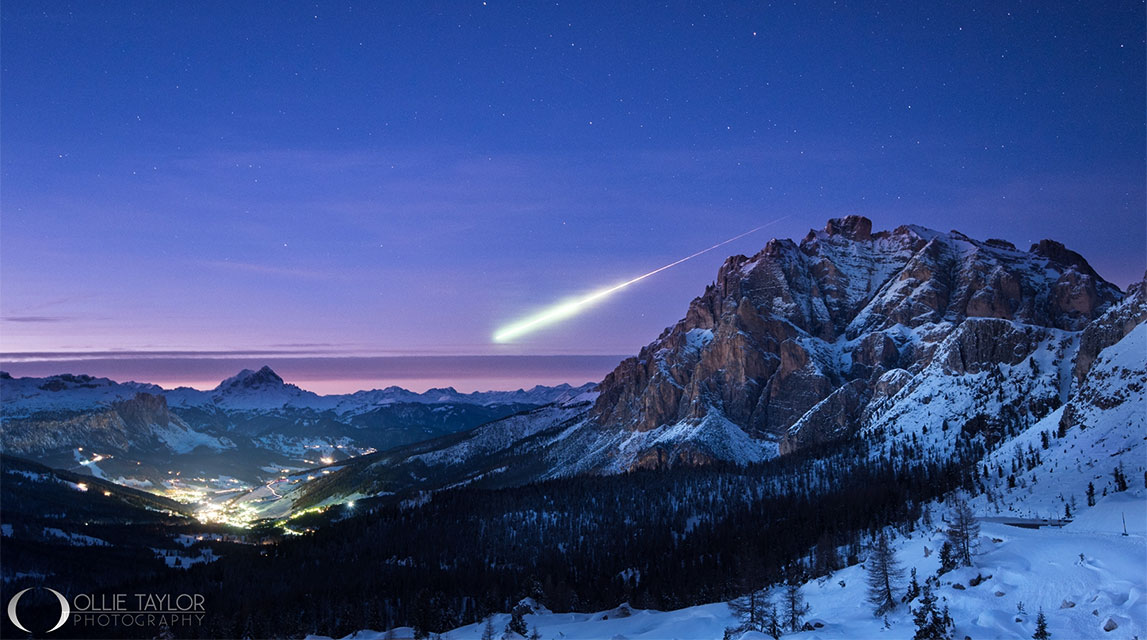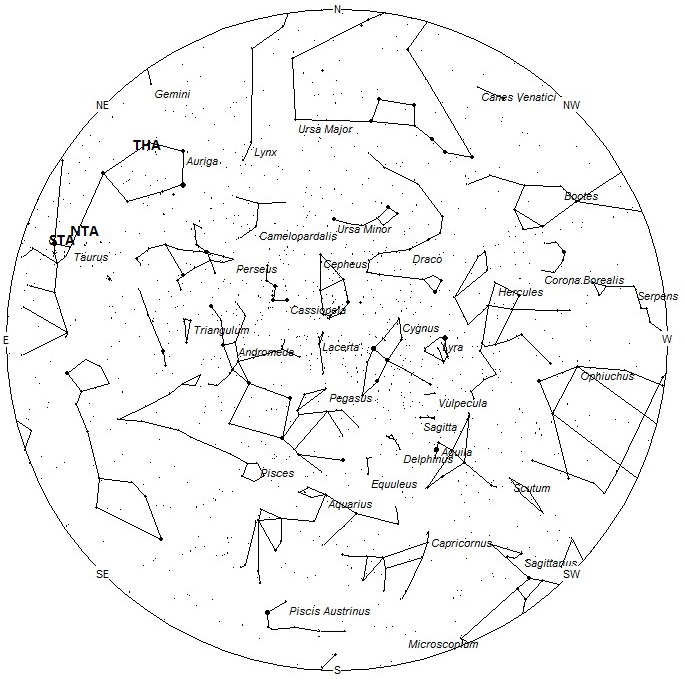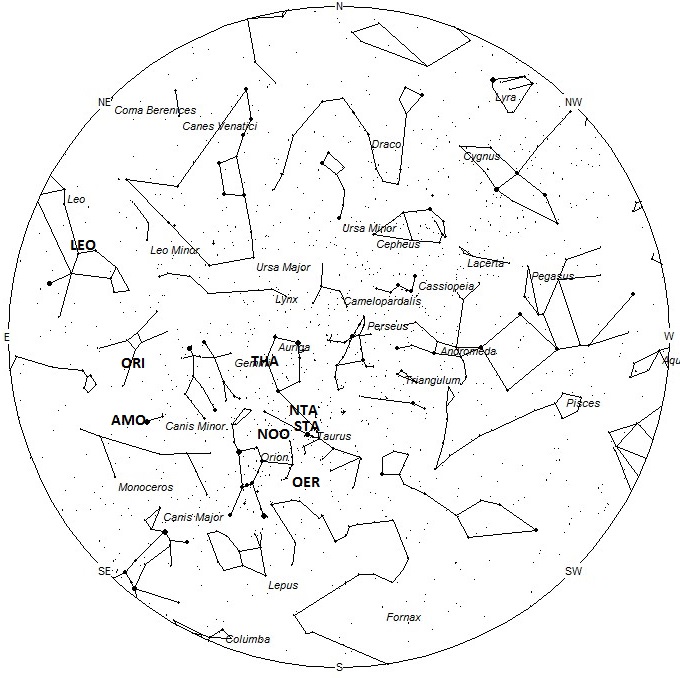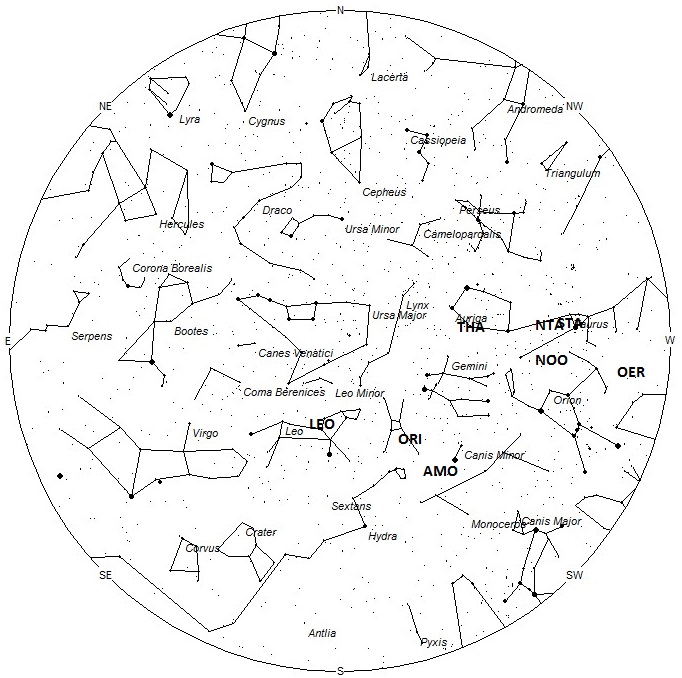
It is the #1 most reported fireball event in the AMS/IMO history – more info here. © Ollie Taylor
During this period the moon will reach its new phase on Saturday November 18th. At this time the moon will lie near the sun and will be invisible at night. Next week the waxing crescent moon will enter the evening sky but will not interfere with meteor observing. The estimated total hourly meteor rates for evening observers this week is near 5 as seen from mid-northern latitudes (45N) and 4 as seen from tropical southern locations (25S). For morning observers the estimated total hourly rates should be near 23 as seen from mid-northern latitudes and 16 from the southern tropics. The actual rates will also depend on factors such as personal light and motion perception, local weather conditions, alertness and experience in watching meteor activity. Note that the hourly rates listed below are estimates as viewed from dark sky sites away from urban light sources. Observers viewing from urban areas will see less activity as only the brighter meteors will be visible from such locations.
The radiant (the area of the sky where meteors appear to shoot from) positions and rates listed below are exact for Saturday night/Sunday morning November 18/19. These positions do not change greatly day to day so the listed coordinates may be used during this entire period. Most star atlases (available at science stores and planetariums) will provide maps with grid lines of the celestial coordinates so that you may find out exactly where these positions are located in the sky. A planisphere or computer planetarium program is also useful in showing the sky at any time of night on any date of the year. Activity from each radiant is best seen when it is positioned highest in the sky, either due north or south along the meridian, depending on your latitude. It must be remembered that meteor activity is rarely seen at the radiant position. Rather they shoot outwards from the radiant so it is best to center your field of view so that the radiant lies near the edge and not the center. Viewing there will allow you to easily trace the path of each meteor back to the radiant (if it is a shower member) or in another direction if it is a sporadic. Meteor activity is not seen from radiants that are located far below the horizon. The positions below are listed in a west to east manner in order of right ascension (celestial longitude). The positions listed first are located further west therefore are accessible earlier in the night while those listed further down the list rise later in the night.
These sources of meteoric activity are expected to be active this week.
.
The Northern Taurids (NTA) are active from a large radiant located at 04:26 (066) +25. This area of the sky is located in northern Taurus, 9 degrees north of the bright orange star known as Aldebaran (alpha Tauri). This position is close to the Southern Taurids so great care must be taken in separating these meteors. You must have the two radiants near the center of your field of view to properly differentiate these sources. Current rates would be 3 per hour as seen from the northern hemisphere and 2 per hour as seen from south of the equator. These meteors may be seen all night long but the radiant is best placed near midnight local standard time (LST) when it lies on the meridian and is located highest in the sky. With an entry velocity of 28 km/sec., the average Northern Taurid meteor would be of slow velocity.
The omicron Eridanids (OER) were discovered by Japanese observers using video data from SonotoCo in 2007-2008. This is a weak shower that usually produces rates less than 1 per hour, even at maximum activity. The radiant is currently located at 04:31 (068) +02, which places it in southeastern Taurus, 6 degrees southwest of the 3rd magnitude star known as Tabit (pi 3 Orionis). These meteors may be seen all night long but the radiant is best placed near midnight LST when it lies on the meridian and is located highest in the sky. With an entry velocity of 29 km/sec., the average omicron Eridanid meteor would be of slow velocity.
The Southern Taurids (STA) are active from a large radiant centered near 04:35 (069) +18. This position lies in central Taurus, 2 degrees north of the orange 1st magnitude star known as Aldebaran (alpha Tauri). These meteors may be seen all night long but the radiant is best placed near midnight LST when it lies on the meridian and is located highest in the sky. Rates at this time should be near 2 per hour regardless of your location. With an entry velocity of 27 km/sec., the average Southern Taurid meteor would be of slow velocity.
The November Orionids (NOO) are active from a radiant located at 05:24 (081) +16. This area of the sky lies on the Taurus/Orion border, 10 degrees north of the 2nd magnitude star known as Bellatrix (gamma Orionis). This area of the sky is best placed in the sky near 0100 LST, when it lies highest above the horizon. This stream is active from November 7 through December 17, with maximum activity occurring on November 29. Rates should be near 2 per hour as seen from mid-northern latitudes and less than 1 as seen from sites south of the equator. With an entry velocity of 43 km/sec., most activity from this radiant would be of medium speed.
The theta Aurigids (THA) were discovered by Dr. Peter Brown using the Canadian Meteor Orbit Radar. This stream is active from November 17 through December 1, with maximum activity occurring on November 26. The radiant currently lies at 05:50 (087) +35, which places it in central Auriga, 2 degrees southwest of the 3rd magnitude star known as theta Aurigae. This area of the sky is best placed in the sky near 0200 LST, when it lies highest above the horizon in a dark sky. Rates should be less than 1 per hour no matter your location. With an entry velocity of 33 km/sec., most activity from this radiant would be of medium-slow velocity. These meteors are expected to be faint and may be difficult to observe unless viewing conditions are near optimum.
The alpha Monocerotids (AMO) are a shower of variable strength capable of outbursts, but usually very quiet. Activity may be seen for a week centered on November 21, but activity is usually limited to November 20-22. Maximum activity is expected on November 21 when the radiant lies at 07:47 (117) +01. This area of the sky lies in southeastern Canis Minor, 4 degrees southeast of the brilliant zero magnitude star known as Procyon (alpha Canis Minoris). This area of the sky is best placed in the sky near 0400 LST, when it lies highest above the horizon in a dark sky. Rates of less than 1 per hour are expected at maximum but there may be a small amount of activity occurring near 21:26 Universal Time. This timing favors eastern Europe and most of Asia. All observations on this date are welcome no matter the time or location as negative results are important too!
The Orionids (ORI) are still active from a radiant located at 08:19 (125) +14, which places it in southwestern Cancer, 5 degrees southwest of the 4th magnitude star known as Asellus Australis (delta Cancri). This area of the sky is best placed in the sky near 0400 LST, when it lies highest above the horizon in a dark sky. Rates should be less than 1 per hour no matter your location. With an entry velocity of 67 km/sec., most activity from this radiant would be of swift speed.
The Leonids (LEO) are active from a radiant located at 10:23 (156) +21. This area of the sky is located in western Leo, only 1 degree northeast of the 2nd magnitude star known as Algeiba (gamma Leonis). Rates are expected to be near 5 per hour Saturday morning, falling slightly with each passing night. Rates seen from the southern hemisphere will be slightly lower. These meteors are best seen during the last hour before dawn when the radiant lies highest above the horizon in a dark sky. With an entry velocity of 70 km/sec., the average Leonid meteor would be of swift velocity.
As seen from the mid-northern hemisphere (45N) one would expect to see approximately 12 sporadic meteors per hour during the last hour before dawn as seen from rural observing sites. Evening rates would be near 4 per hour. As seen from the tropical southern latitudes (25S), morning rates would be near 8 per hour as seen from rural observing sites and 3 per hour during the evening hours. Locations between these two extremes would see activity between the listed figures. Morning rates are reduced during this period due to moonlight.
The list below offers the information from above in tabular form. Rates and positions are exact for Saturday night/Sunday morning except where noted in the shower descriptions.
| SHOWER | DATE OF MAXIMUM ACTIVITY | CELESTIAL POSITION | ENTRY VELOCITY | CULMINATION | HOURLY RATE | CLASS |
| RA (RA in Deg.) DEC | Km/Sec | Local Standard Time | North-South | |||
| Northern Taurids (NTA) | Nov 02 | 04:26 (066) +25 | 28 | 00:00 | 3 – 2 | II |
| omicron Eridanids (OER) | Nov 04 | 04:31 (068) +02 | 29 | 00:00 | <1 – <1 | IV |
| Southern Taurids (STA) | Oct 29-Nov 03 | 04:35 (069) +18 | 27 | 00:00 | 2 – 2 | II |
| November Orionids (NOO) | Nov 29 | 05:24 (081) +16 | 43 | 01:00 | 2 – 1 | II |
| theta Aurigids (THA) | Nov 26 | 05:50 (087) +35 | 33 | 02:00 | <1 – <1 | IV |
| alpha Monocerotids (AMO) | Nov 21 | 07:47 (117) +01 | 63 | 04:00 | <1 – <1 | IV |
| Orionids (ORI) | Oct 22 | 08:19 (125) +14 | 67 | 04:00 | <1 – <1 | I |
| Leonids (LEO) | Nov 17 | 10:23 (156) +21 | 70 | 06:00 | 4 – 3 | I |







 You saw something bright and fast? Like a huge shooting star? Report it: it may be a fireball.
You saw something bright and fast? Like a huge shooting star? Report it: it may be a fireball.  You counted meteors last night? Share your results with us!
You counted meteors last night? Share your results with us!  You took a photo of a meteor or fireball? You have a screenshot of your cam? Share it with us!
You took a photo of a meteor or fireball? You have a screenshot of your cam? Share it with us!  You caught a meteor or fireball on video? Share your video with us!
You caught a meteor or fireball on video? Share your video with us!
3 comments
I was clouded out for the peak of the Leonids, but on the morning of November 19/20 I was able to get a good hour in with clear LM=6.5 skies from Mathias, West Virginia. From 4:42 to 5:42 EST I was able to see 11 Leonids. The average Leonid was a relatively bright 1.6 magnitude and left a train. I also saw 3 NTA, 3 STA, 1 NOO, 1 AMO, and 9 SPO.
Screech Owl Hill Observatory
Mathias, West Virginia
Very poor activity observed the night from saturday to sunday. Your forecast was good. Regards.
I am studying in Slovakia and now I just saw the biggest I have ever seen, and it even made a sound ! It was so creepy I almost could think it was a atombomb..